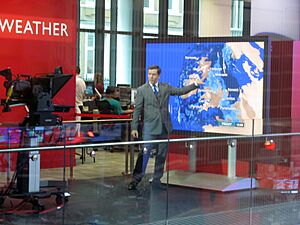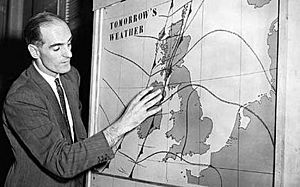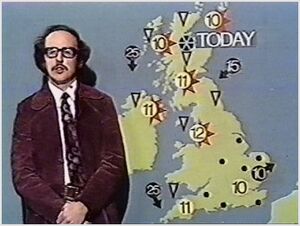BBC Weather facts for kids

Logo used since 2022
|
|
| BBC department | |
| Industry | Broadcasting |
| Headquarters | Broadcasting House, , |
|
Area served
|
United Kingdom Rest of the world |
| Owner | BBC |
BBC Weather is a special part of the BBC (British Broadcasting Corporation). It is in charge of creating and sharing weather forecasts for everyone.
For a long time, the BBC got its weather information from the government's Met Office. This partnership lasted for 94 years! However, in February 2018, BBC Weather started working with a different company called MeteoGroup. Then, in July 2025, the BBC shared exciting news: it would be working with the Met Office again in the future.
Contents
The Story of BBC Weather
The very first BBC weather forecast was for ships at sea. It was broadcast on the radio in November 1922. Daily weather forecasts for everyone started in March 1923.
In 1936, the BBC tried out the world's first TV weather maps. These maps filled the whole screen. Someone off-screen would read out the next day's weather. This became a regular thing after World War II in 1949.
How Technology Changed Weather Forecasts
On January 11, 1954, something new happened. The first "in-vision" weather forecast was shown. This meant the presenter, George Cowling, stood in front of the map. Back then, maps were drawn by hand and rushed to the BBC. The same person who made the forecast also presented it.
In 1962, new machines like fax machines and electronic computers helped the Met Office. This made forecasts much more accurate and faster to create.
Satellite photography became available in 1964. At first, the pictures were not very clear. Coastlines had to be drawn on them with a felt-tip pen. Things got much better in 1973 with a powerful new computer. This made forecasts twice as good!
Amazing Graphics and Symbols
As computers got better, so did the weather graphics. Hand-drawn maps were replaced by magnetic symbols. Then came bluescreen technology, which uses computer-generated imagery. This gave presenters more control over what they showed.
Early magnetic symbols sometimes fell off the maps! Also, presenters occasionally made spelling mistakes. But these symbols helped show how the weather would change. They were designed so viewers could understand them without needing a key.
In February 1985, computer graphics were introduced. The basic weather symbols stayed the same. These new forecasts were praised for being simple and clear. They even won an award in 1993!
In October 2000, BBC Weather changed again. New symbols were added for things like pollen and sun levels. A more detailed map of Britain, made with satellite data, was also used.
The Great Storm of 1987
One of the most famous BBC weather presenters is Michael Fish. He was known for his friendly style and fun clothes. He once wore a blazer covered in weather symbols!
Before the Great Storm of 1987, Michael Fish made a comment that many people remember. He said, "Earlier on today, apparently, a woman rang the BBC and said she heard there was a hurricane on the way. Well, if you're watching, don't worry, there isn't." He was technically right because hurricanes rarely reach the UK. He was actually talking about a hurricane in Florida. He then correctly predicted stormy weather for southern England. But his comment became famous as a big public mistake.
Weatherscape XT Graphics (2005–2018)

In May 2005, the weather symbols changed after almost 30 years. The flat map became a 3D globe. Weather was shown by colored areas. Cloud cover was shown by how bright the map was. Rain and snow were shown by moving blue and white areas. These graphics were made by a company called Weatherscape XT.
Some people liked the new look, saying it was more modern. Others did not like the brown color for land. They also thought the new graphics were too expensive. The way the map was angled made Scotland look much smaller than Devon. This made some people in Scotland feel that the BBC favored London. So, the map was changed to show the UK better.
The new look won an award in 2006. But some viewers still complained about the colors and not enough detail for forecasts beyond 36 hours. In 2006, a rippling effect was added to show seas and oceans.
BBC Weather Changes Provider
In August 2015, the BBC announced that the Met Office would no longer provide its weather forecasts. The BBC said it had to get the best value for money for TV licence payers. The presenters stayed the same. The BBC also continued to share warnings from the Met Office and the Shipping Forecast.
After a competition, MeteoGroup (now part of DTN) was chosen as the new provider in August 2016. MeteoGroup started providing data for forecasts in September 2017.
On February 6, 2018, the BBC started using new graphics from MeteoGroup. These included:
- A "window on the weather" at the start of each forecast.
- Green land on the maps.
- High-quality moving graphics showing detailed weather.
- More "realistic mapping" and a "realistic globe."
- Forecasts that were easier for people with color-blindness to see.
- The ability to zoom in on specific areas for more detail online and on TV.
- A 'chance of precipitation' feature on the app.
- A 'feels like' factor on the app, showing how cold it feels.
- Up to a 7-day forecast on TV and radio.
- Up to 14 days of hourly forecasts online and on the app.
Many people shared their thoughts about the new design. Some viewers were not happy with the changes to the BBC Website and weather apps.
BBC Weather Works with Met Office Again
On July 30, 2025, the BBC announced that it would be working with the Met Office again. This means they will no longer partner with DTN. This agreement is not about money. It is a partnership between the two groups to help the public.
Who Are the National Forecasters?
National forecasters also provide forecasts for local news programmes.
Current Forecasters
- Philip Avery
- Darren Bett
- Stav Danaos
- Chris Fawkes
- Alina Jenkins
- Sarah Keith-Lucas
- Simon King
- Carol Kirkwood
- Louise Lear
- Susan Powell
- Ben Rich
- Elizabeth Rizzini
- Tomasz Schafernaker
- Matt Taylor
- Helen Willetts
Former Forecasters
- Jack Armstrong
- Jim Bacon
- Bill Bruce
- Suzanne Charlton
- T. H. Clifton
- Peter Cockroft
- Daniel Corbett
- George Cowling
- Bernard Davey
- Alex Deakin
- Liam Dutton
- Richard Edgar
- Barbara Edwards
- Michael Fish
- Bert Foord
- Everton Fox
- Peter Gibbs
- Bill Giles
- John Hammond
- John Kettley
- Tori Lacey
- David Braine
- David Lee
- Lucy Martin
- Kirsty McCabe
- Ian McCaskill
- Rob McElwee
- Nick Miller
- Graham Parker
- Anne Purvis
- Nina Ridge
- Elizabeth Saary
- Jack Scott
- Laura Tobin
- Penny Tranter
- Sarah Wilmshurst
- Francis Wilson
- Owain Wyn Evans
- Jay Wynne
- Helen Young
Online Weather Forecasts
The BBC Weather website offers weather forecasts for places in the UK and around the world. It uses animated symbols, similar to the TV broadcasts. The website first launched in 1997.
The website also has special features about sports, nature, and weather science. You can find world weather, UK outlooks, and weather news there.
In October 2024, a technical problem caused the BBC Weather website and app to show incorrect wind speeds and temperatures. For example, it showed wind speeds over 15,000 kph and temperatures over 400°C!
BBC Weather Apps
On May 20, 2013, the BBC released the BBC Weather App. It was available for iOS devices (like iPhones) and Android devices. These apps were designed by Media Applications Technologies and used data from the Met Office.
See also
- National, regional, and retired BBC weather forecasters



